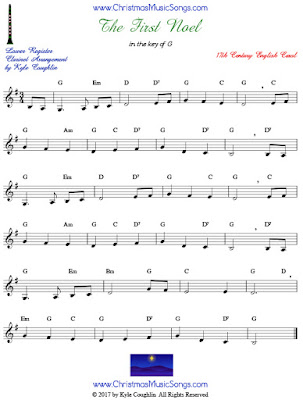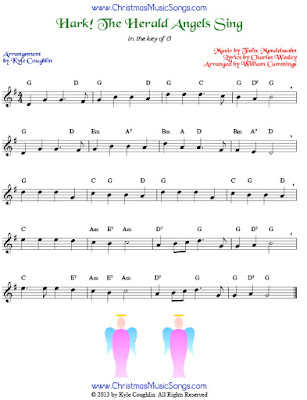Only one week until Christmas, but that’s plenty of time to learn and play new carols! As promised in my last post, the newest additions to Christmas Music Songs are arrangements for piano. My goal is to provide several arrangements of each carol so that pianists of all levels can find something they are looking for. All of these arrangements are available as free, printable PDFs. As of now, there are three different versions of twenty eight carols, with more arrangements on the way. The versions are progressively difficult, with arrangements suitable for beginners to more advanced players.
Version 1 of each carol features just the melody, written in the treble clef staff. Beginners or pianists who only want the melody can use these arrangements. The songs are written within the staff and avoid ledger lines whenever possible. Most of the songs are in the key of C, G, or F. Instead of using key signatures, I have included accidentals where needed. This arrangement of Joy to the World demonstrates the Version 1 arrangements.
Version 2 of each carol features the melody split between both hands, using treble and bass clefs on the grand staff. At first glance, these arrangements might look a bit confusing, but once students begin playing them, they will see that the music is not very complicated. The Version 2 songs are a great pedagogical tool to help students learn the melody while using both hands and developing their coordination. For many of the carols, students can perform the melody without ever changing hand position. Like the Version 1 carols, they do not have key signatures, but use accidentals. This arrangement of Deck the Hall shows how the Version 2 arrangements use both hands.
The third version of each carol is a bit more challenging than the first two. The melody is written entirely in the right hand in treble clef. The left hand now has a basic accompaniment role, playing a simple rhythmic line that usually represents the root of each harmony. Sometimes, to provide for better voice leading, the left hand will play the third or fifth of a chord. These arrangements of the carols do use key signatures. Here is a Version 3 arrangement of Jingle Bells.
Besides offering pianists of different levels carols that match their ability, these arrangements can provide students and teachers with a nice pedagogical tool to help them develop their technical and musical skills while performing fun Christmas songs. Since the piano is not my main instrument, I consulted the outstanding pianist and teacher Dr. Kuei-I Wu. She gave excellent assistance in helping me determine the difficulty of each arrangement, and she provided great pedagogical ideas. Thank you Kuei-I !!!
Coming up next — more versions of the Christmas carols for piano, with more interesting accompaniments and harmonies.










